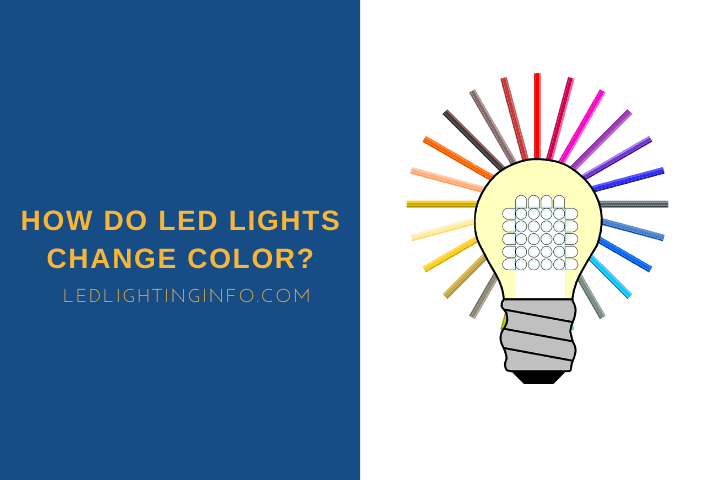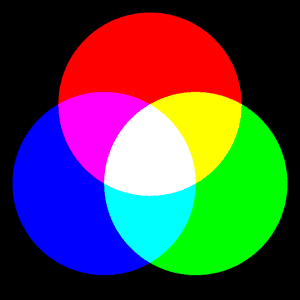Gone are the days of using lighting gels to change the color of a light source. Nowadays, one small diode is enough to supply an endless amount of colors.
But what is it about LEDs, in comparison to traditional bulbs, that allows them to change color? How can something so technologically advanced be so small?
A color-changing LED contains three separate diodes within the same bulb casing. Each of these diodes emits its own, specific color – red, green, or blue. When all three diodes are switched on at full capacity, white light is produced. Adjusting the intensity of each diode allows a range of different colors and shades to be created.
Colored LEDs are all around us. As well as decorative applications, they’re being used for communication and indication purposes. Just look at the Amazon Echo!
Want to know more? Then let’s get started. In this blog, I’ll be talking about how colored LEDs work, whether you can change the color of your existing LEDs, and how color differs from color temperature.
The Difference Between Color and Color Temperature

‘Color’ refers to the color of light that the diode emits – this can be any color of the rainbow. Color temperature, whereas, refers to the shade of white light emitted. White lights can produce warmer or cooler visual effects, and this is measured in degrees Kelvin.
The Kelvin scale was established by a British physician, Lord Kelvin, who researched color changes in heated metals. He found that as the temperature of a black material increases, its color changes from red to yellow and eventually blue.
Unlike air temperature, measured in Celsius or Fahrenheit, warm color temperatures have low Kelvins, and cool color temperatures have high Kelvins. The Kelvin scale runs from 0 – 10,000K, but most LEDs will be between 2,000 and 6,500K.
How Does LED Change The Color?
LEDs can generate up to 16 million colors. So how do they work?
Colored LEDs are made up of 3 diodes: red, green, and blue (RGB). The RBG concept is an additive model, these colors are used because our eyes see all colors as different combinations of red, green, and blue wavelengths.
But let’s review this concept a bit more in depth.
The RGB Concept Explained
Let’s take a colorful walk down memory lane. You might remember from school that mixing blue and yellow color pencils on paper made the color green. And that primary colors are red, blue and yellow, and you mix them to make secondary colors.
Interestingly, this model of mixing colors is only ONE of the two models that exist in the visible world.
The second mentioned is the subtractive CMYK model, where the absence of color means white. The source of color is that the corresponding wavelength of sunlight not absorbed by an object, but is reflected back to our eye.
This color model is used for photos and magazine printing, for example, where various colored inks are mixed to make more hues.
Now we come to the additive model of color mixing, where the absence of color means black. The source of color is light photons using different metal alloys.
Red and amber LEDs use the aluminum indium gallium phosphide (AlInGaP) material system. Green diodes, whereas, use gallium phosphide and blue diodes to use indium gallium nitride.
This is how the RGB colors came about, where primary colors are red, green, and blue.
This is what concerns us in this blog, as TVs, monitors, and electronics use this color mixing method. They illuminate RED, GREEN, or BLUE lights in a black pixel with varying intensities to produce over 16 million colors.
Current passing through all 3 diodes at equal intensity produces white light. Since LEDs are so small and the diodes are so close together, our eyes see the combination of colors, rather than each individual colored diode.
By adjusting the current so that it only flows through 2 diodes, an additional 3 colors can be created. Passing a current through the red and blue diodes creates magenta, red and green make yellow, and blue and green produces cyan.
Here is the table that represents the main color outputs you will get by mixing different colors.
| Red | Green | Blue | LED Color |
|---|---|---|---|
| ✓ | ✓ | ✓ | White |
| ✓ | ✘ | ✘ | Red |
| ✘ | ✓ | ✘ | Green |
| ✘ | ✘ | ✓ | Blue |
| ✓ | ✘ | ✓ | Magenta |
| ✓ | ✓ | ✘ | Yellow |
| ✘ | ✓ | ✓ | Cyan |
Alternating The Current To Each RGB Stream
Beyond this, other colors are created by adjusting the level of current running through each diode. If, for example, the red and green diodes are switched on but the green is running at 50%, a color between red and yellow will be created. In this case, orange.
Now check out some cool math to show you the number of possible colors from an RGB LED.
To quantify the intensity of each diode, the RGB model uses a color code. You’ll probably be familiar with this if you have experience in graphic design or web development.
Under the RGB color code, each diode is given a decimal value between 0 and 255. So the color code for orange, to follow on from the earlier example, would be 255, 128, 0. This can also be presented in percentage form, 100%, 50%, 0%.
Since each of the three colors can be set to 256 values (including zero), 256*256*256 = 16,777,216 possible colors are at your disposal with the slide of a remote.
Yes, all that by mixing just three primary colors.
To see how it works, you can play around with this color picker. Simply adjust the value of RGB colors and see what the end result is.
In color changing LEDs, a microcontroller is used to control whether each diode is switched on or off. To dim a diode, whereas LEDs use Pulse Width Modulation (PWM).
As the name suggests, PWM works by rapidly turning the diode on and off. This flickering is so fast that it is undetectable to the human eye. Hence, our eyes only see the net result i.e., the color.
Most LEDs flicker at 1000Hz, but the human eye can only identify flickers slower than 200Hz.
What Is The Difference Between RGB and RGBW LED Lights?
A standard RGB LED uses 3 colored diodes, the RGBW on the other hand uses 4 diodes, the extra one being a white diode.
This white diode outputs pure white light, so when you need white color, only the white diode is working. The rest of the three kick into action when you need colors.
This is where the RGBW LEDs really shine! An RGBW LED can produce bright pastel colors in addition to all the colors the RGB light produces.
Additionally, and more importantly, owing to the high CRI white LED, RGBW’s light output is suitable for task or mood lighting, and you can see objects well.
That’s not all!
The RGBW LED can also change the color temperature of the light produced!
If you want task lighting, the white and blue diodes merge lighting to produce a cool temperature. If you want to relax, the red and white diodes give you that familiar warm white color.
If you do not require brightness or task-based lighting, then the basic RGB LED can be enough to provide color and aesthetics.
The final key difference is the quality of the white light produced.
Obviously, in the RGBW LED, the white color produced is a purer tone of white, while in RGB, the three colors come together and make a slightly bluish-white, which can be off-putting.
Here’s a cool video demonstrating the difference in the brightness and color range between an RGB and an RGBW LED.
How Does LED Change The Color Temperature?
All in all, adjusting the color of an LED is fairly simple, but can the same be said for changing the color temperature of a bulb?
Unfortunately, it’s not that easy. LEDs are manufactured to produce specific Kelvin colors, which means once they’re constructed, the color temperature is fixed and cannot be changed.
Warm lights have a relaxing impact, and blue lights help to keep us alert. So this is frustrating, as some areas of the home are used for both relaxing and concentrating. You cannot have the best of both worlds.
Luckily, manufacturers have come to appreciate this situation and have innovated LED fixtures with changing color temperatures. These fixtures combine two sets of LED chips, cool and warm temperatures, which users can alternate between.
Take a look at this video by SIRS-Electronics to get a better understanding of how temperature-changing LEDs work:
Can You Alternate Colors Of The Bulb?
Despite the technology being relatively simple, color-changing LEDs are difficult to customize. Let’s break it down.
Firstly, there are two types of color LEDs: single and multi-colored. If a LED is always going to be a fixed red color, for instance, it would be wasteful to include the green and blue diodes inside the casing. Since they would always be switched off.
This means it’s physically impossible for single color LEDs to change color because they don’t have the required components.
Alternatively, most colored LEDs will contain all three primary colored diodes. They may be able to cycle through a variety of colors, but combinations will be predetermined by the LEDs manufacturer.
The color that light can emit is controlled by a small on-board computer. Unless you have access to this computer, it’s unlikely that you will be able to customize the colors of your LEDs.
Nevertheless, over the past year, smart LEDs have surged in popularity. This innovative technology allows you to control the color of LED lights via remote control or smartphone app.
Can You Convert Standard White LED Into RGB?
So, you have an idea of setting up your cozy corner, and you think you have some LED strips in storage. Unfortunately, it turns out, they’re plain white!
Can you make them into RGB and get color somehow?
Sadly, no. As I said before, barring a few improvised sanding and coloring in home hacks, you can’t change your regular single white color LED into the three colored RGB LED.
But don’t let it discourage you as it is a great opportunity to do some DIY painting job on bulbs with your kids.
Final Words
There you have it, the technology behind color-changing LEDs is surprisingly straightforward.
This color effect is specific to LEDs, and cannot be applied to traditional halogen or incandescent light bulbs.
So it’s no surprise that LEDs are becoming increasingly popular and are gradually being integrated into a whole array of devices.
What’s your opinion on colored LEDs – will you be introducing them to your home or keeping them in the loft with the Christmas and Halloween decorations?
Let me know in the comments below!
Looking for an LED bulb but not sure what type you need?
Check out my free bulb picker and select the right bulb within few clicks.



Comments are closed.